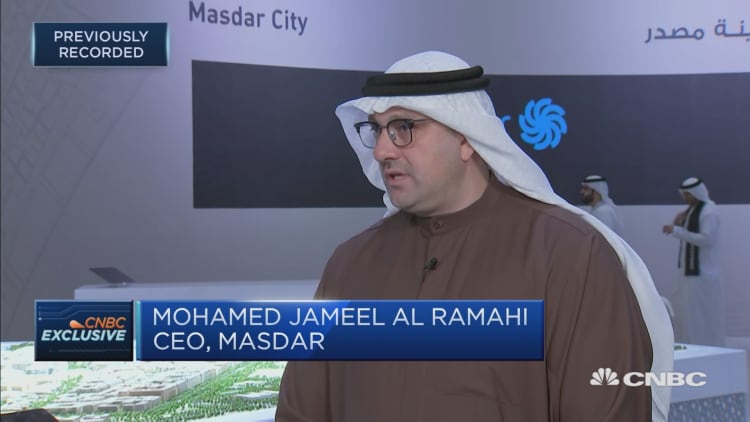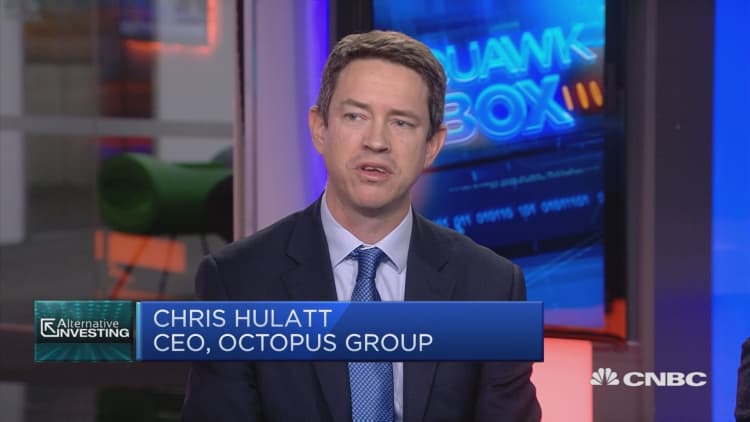
The Abu Dhabi Future Energy Company, also known as Masdar, has acquired stakes in two U.S. wind farms in what will be its first-ever foray into the North American market.
The company, a subsidiary of Emirati investment vehicle Mubadala Investment Company, on Tuesday announced its share purchase agreement to buy British developer John Laing Group's interest in wind farms in Texas and New Mexico. While the exact dollar value of the deal has not been disclosed, Masdar's leadership described it as being "north of $100 million."
The 149 megawatt (MW) Rocksprings project in Texas is home to 53 of General Electric's 2.3MW wind turbines and 16 of its 1.72MW turbines in Val Verde County, while the Sterling project in New Mexico's Lea County has a total installed capacity of 29.9MW provided by 13 of General Electric's 2.3MW turbines.
Masdar Chief Executive Mohamed Jameel Al Ramahi spoke to CNBC's Dan Murphy about the move Tuesday while at Abu Dhabi's Sustainability Week, calling the U.S. "a very important market not only for Masdar but the renewable energy world." Last year's conference by the same name saw $15 billion worth of deals announced.
Indeed, America saw a record 6.3 percent of its electricity generated from wind in 2017, and is home to "one of the largest and fastest-growing wind markets in the world," according to the U.S. Department of Energy. The country installed over 7,000 MW of wind energy capacity in 2017, according to data from the Global Wind Energy Council, putting it behind only China in terms of new installations.
'Double-digit growth' in renewable energy use
Al Ramahi stressed the growing potential of America's clean energy market, despite the Donald Trump administration's focus on coal and other traditional power sources.
"Regardless of what you hear, about renewables or against them, what we see in the U.S. is a high double-digit growth in the adaptation of renewable energy," the CEO said, adding that this trend was evident around the world as well.
"Obviously policy makers and politicians are important for the advancement of capital flow in certain sectors, but regardless of this, we see the U.S. as still a growth market for renewable energy, we are happy to enter the U.S. today, and we continue pursuing further opportunities for the U.S. for sure."
Those other opportunities could include solar power as well as renewable energy storage, Al Ramahi said.
The Masdar chief went on to describe the pickup in renewable energy consumption around the world, and stressed the industry's growing importance not just to strategic diversification of national energy portfolios, but to commercially viable investment as well.
More than just diversification
He said that more and more countries around the region were adopting renewable energy into their energy mix, pointing to the targets of Saudi Arabia, Kuwait, Oman, Jordan, Egypt, and across North Africa, whose governments are now working to move away from historic dependence on fossil fuels.
"It started as a strategic approach to get away from their dependence on fossil fuels, but today it's not only about strategic adaptation. Today renewable energy makes commercial sense," Al Ramahi said. "So it actually competes with pricing with conventional power generation."
Renewable power generation costs are coming down by the year. The period between 2010 and 2016 saw a 69 percent decrease in the cost of electricity from solar photovoltaics and an 18 percent cost decrease for onshore wind, putting the former "well into the cost range of fossil fuels," according to the international Renewable Energy Agency.

Renewables provided 8 percent of the world's electricity in 2017, according to statistics from BP. While this remains a small fraction of the global energy mix, it's a 17 percent jump from the year before and accounted for nearly half of 2017's global power generation growth. Worldwide, wind power generation grew by more than 17 percent in 2017 to reach 4.4 percent of total world electricity generation.
And despite the U.S.'s withdrawal from the COP21 climate agreement, the remaining signatories of the Paris accord have set high capacity installation targets for the next 10 to 15 years.
"So Masdar is positioned correctly ... We are well positioned to take advantage of such opportunities in our region," Al Ramahi said.
Masdar's renewable energy portfolio currently spans more than 25 countries, delivering more than 1.3GW of solar power and 1.4GW of wind energy annually.
Correction: This story has been updated to reflect that Masdar is a subsidiary of Emirati investment vehicle Mubadala Investment Company.





